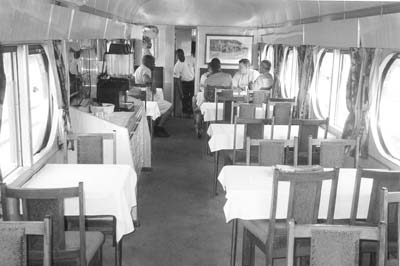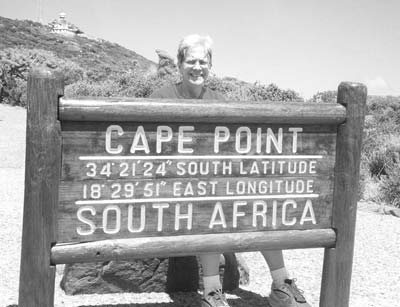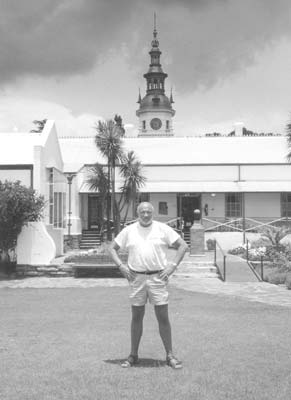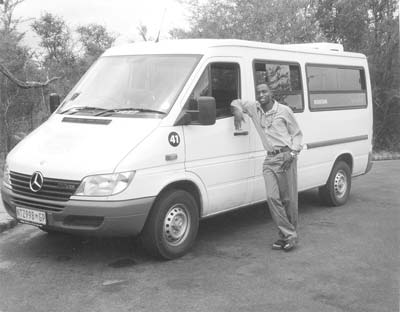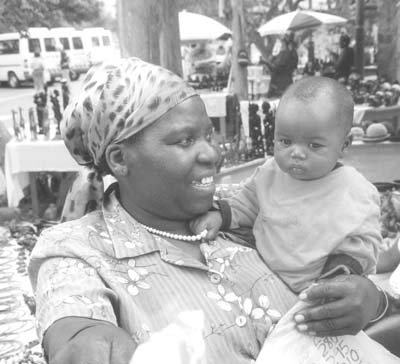Discovering diverse landscapes and cultures on a six-country African rail journey
by Vern Lewis, Atlanta, GA
An extended trip to Southern Africa: that’s what my sister Patt and I took in January and February ’03. The highlight would be a 16-day rail tour that departed from Johannesburg and took us to a total of six countries.
We began with a week in Cape Town. Because of the extreme distance, we chose to fly first class on South African Airways — $9,250 each, round trip from Atlanta to Cape Town.
We stayed at the Protea Hotel President (4 Alexander Rd.; phone 2721 434 8111 or visit www.protea-hotels.co.za) at Bantry Bay with a sweeping view of the Atlantic surf ($140 per night).
Each day we explored the area using a different route, beginning with a dramatic drive to Cape Point near the Cape of Good Hope, dodging ostriches and baboons on the road.
We also took a ferry trip to the prison on Robben Island where Nelson Mandela spent 18 years; a drive to the wine country, including Stellenbosch and Paarl plus stops at the cheetah reserve at Spier Winery and an elegant lunch at Boschendal Winery, and a cable-car trip to the top of Table Mountain, with a few hours of scenic hiking.
We explored the sights of Cape Town as well, particularly the Victoria & Alfred Waterfront.
Patt quickly adapted to driving on the left side of the road, which came in handy the day we went to the wine country. Patt doesn’t like wine, so I got double portions. Isn’t life grand?
Shongololo Express
At the end of the week we flew to Johannesburg, where we were met by a friendly tour guide from Shongololo Express. We had booked our rail journey on the Southern Cross through Shongololo Express’ U.S. agent, Wild African Ventures (10505 Wheatland Ave., Shadow Hills, CA 91040; phone 800/358-8530 or visit www.wildafricanventures.com).
We paid $3,920 each for an Emerald Class suite, which was well worth it. There were three such suites per railcar, each with a separate bedroom, a small parlor and a bathroom. Unlike less expensive cabins, Emerald suites also have air-conditioning, which we found essential in heat that sometimes reached 100°F.
It was a surprise to learn that our Shongololo train did not have an engine. Rather, in each country visited, the company contracts with the national railways to pull the train, which can cause some unexpected delays.
Anticipation
The trip began with our small group boarding one of the 12-passenger vans which Shongololo carries on the train and uses for excursions each day. Most of the train’s movement is during the night, when passengers are sleeping. This motion can range from soothing to quite jolting, due to some rough tracks.
The van took us to Pretoria, the administrative capital of South Africa, to visit the home of Paul Kruger, president of Transvaal (or the South African Republic), which became part of South Africa after the Boer War. After lunch we drove to Soweto, home to an estimated 3,000,000 black Africans who were forced to live there until apartheid ended in 1994. Freedom has helped somewhat, but the people of Soweto have not benefited much from South Africa’s economic progress.
We were eager to experience meals on the train, and we were not disappointed. Although short of gourmet quality, each evening we were served an appetizing 4-course dinner. The dining room staff was very responsive to Patt’s request for vegetarian meals, and a nice selection of South African wines was available.
Swaziland
The next morning we awoke to find that we were near the border of the small kingdom of Swaziland. After a buffet breakfast, we worked our way through what was to become routine at each national border: a ceremonious ritual of standing in line, waiting for an agent of the country we were exiting to pompously stamp our passport, then walking a short distance to the Immigration agent of the country we were entering to repeat the ritual. They would sometimes collect $10 or $20 for an invisible “visa.”
The drive into Swaziland revealed a lush and prosperous country, mostly agricultural. We visited a glass factory and a candle factory, both very artistic.
The prosperity diminished as we drove eastward. Our guide explained that during the civil war in neighboring Mozambique, throngs of refugees had crowded across the border into Swaziland, where most of them remain without adequate resources.
By the time we reached the border, large groups of begging children were stretching their hands toward our van.
I must say that I had a feeling of guilt for having such a nice life and felt helpless while witnessing such extreme poverty and suffering. The other side of the coin, of course, is acknowledging that, by traveling to these countries, we are helping to restore their economy.
Mozambique
After we crossed into Mozambique and approached the capital city of Maputo, we were shocked at the squalor and disrepair of the buildings. Mozambique, a former Portuguese colony, gained independence in 1975 and promptly launched into a 17-year civil war, causing much of the nation’s infrastructure to be destroyed. To make matters worse, in 2002 Maputo suffered a major flood that washed right through the center of the city.
After spending two days in Mozambique, we were delighted to return to South Africa to spend two days game viewing at world-famous Kruger National Park. Within a few hours we saw elephants, leopards, lions, impala, zebras, baboons, giraffes, wart hogs, ostriches, buffalo, monkeys, hippos and rhinos. In fact, the first day was so overwhelming that Patt and I took the second day off to just relax in our comfortable suite on the train while catching up on our reading and enjoying the complimentary bottle of champagne.
Zimbabwe
After hearing bad news about the economy and the state of civil rights in Zimbabwe, we were anxious about visiting there, and rightfully so!
The only traffic we saw on the main highway was buses overpacked with people headed toward the border, plus an occasional truck. There was virtually no petroleum available in Zimbabwe because there was no money to import it, as was the case with most other commodities. Empty cars were lined up for over a mile at gas stations so they would be in position to get some gasoline if it ever arrived.
The hotel restaurants where we had lunch were unable to maintain a selection of soft drinks. Nonetheless, the countryside of Zimbabwe was still beautiful. Some of the “protected” animals have been killed for food, but Hwange game reserve, which we visited, had abundant wildlife.
(Note: the U.S Department of State has a current travel warning reminding Americans of the political, economic and humanitarian crises in Zimbabwe.)
Victoria Falls and Chobe National Park
After a lengthy journey over some really poor tracks, the train reached our final destination, Victoria Falls. Shortly after arrival, we took the vans across the border into Zambia to view the falls.
The Zambezi was flowing high, so the falls were at their best. As a special treat that evening, the train moved out onto the International Bridge so we could view the falls at sunset. It was spectacular!
The next day was one of the best. We drove to the border of Botswana and boarded special open-air safari vehicles to tour Chobe National Park.
Our first stop featured a river boat tour of the Chobe River estuary, which is shared by Botswana and Namibia. It was just one delight after another — crocodiles only feet from our boat, hippo families grazing on the thick grass just yards away and elephants that we could almost touch.
From there we drove through Chobe for some of the best wildlife viewing we have experienced.
A dance by the tour staff and guests on the railway platform at the Victoria Falls station capped off the final evening.


